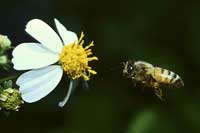Jun 29 2008
Scientists are one step closer to understanding the recent demise of billions of honey bees after making an important discovery about the transmission of a common bee virus. Deformed wing virus (DWV) is passed between adult bees and to their developing brood by a parasitic mite called Varroa destructor when it feeds. However, research published in the July issue of the Journal of General Virology suggests that the virus does not replicate in Varroa, highlighting the need for further investigation.

Deformed wing virus has been linked to the collapse of honey bee colonies in Britain. In recent years the prevalence of the virus has increased globally in colonies infested with Varroa. It is widely accepted that the virus replicates in the mite and is then transmitted to bees when it bites. However, researchers at Rothamsted Research and the University of Nottingham have found that the virus does not replicate in the mite, suggesting an alternative means of transmission.
"Experiments and field observations have shown that V. destructor is able to transmit several different unrelated honey bee viruses, like acute bee paralysis virus and Kashmir bee virus as well as deformed wing virus," said Professor Teresa Santillan-Galicia from Rothamsted Research. "But we still don't know exactly how these viruses are passed from the mite to the bee."
The researchers wanted to find out whether the virus replicates in the mite and if so where this occurs, to understand how the virus is transmitted. They used a process called immunohistochemistry which involves using antibodies which bind to specific surface proteins, enabling the virus particles to be located. There was no evidence of virus replication within the cells of the mite; the virus was found only in the lumen of the gut, suggesting it was merely eaten.
"The presence of deformed wing virus in large amounts in mite faeces suggests it is picked up during feeding on an infected bee," said Professor Santillan-Galicia. "However, one important question remains – how is the virus transmitted to bees?"
One possibility is that the mouthparts of the mite could become contaminated with the virus during feeding, but this is an unlikely answer. Varroa mites cannot regurgitate their gut contents as there is a membrane in the oesophagus that acts as a non-return valve, so they could not pass the virus on this way either. Unfortunately, not enough is known about the anatomy of the mite, or their feeding mechanism, to suggest other routes of transmission.
"It is likely that the amount of virus acquired by the mite plays an important role in the interaction between deformed wing virus and the Varroa mite," said Professor Santillan-Galicia. "Full understanding of the interaction between deformed wing virus and the Varroa mite will provide basic information for the future development of more sustainable control strategies against the mite and the virus. Our work provides elements of understanding but further research in this area is needed."